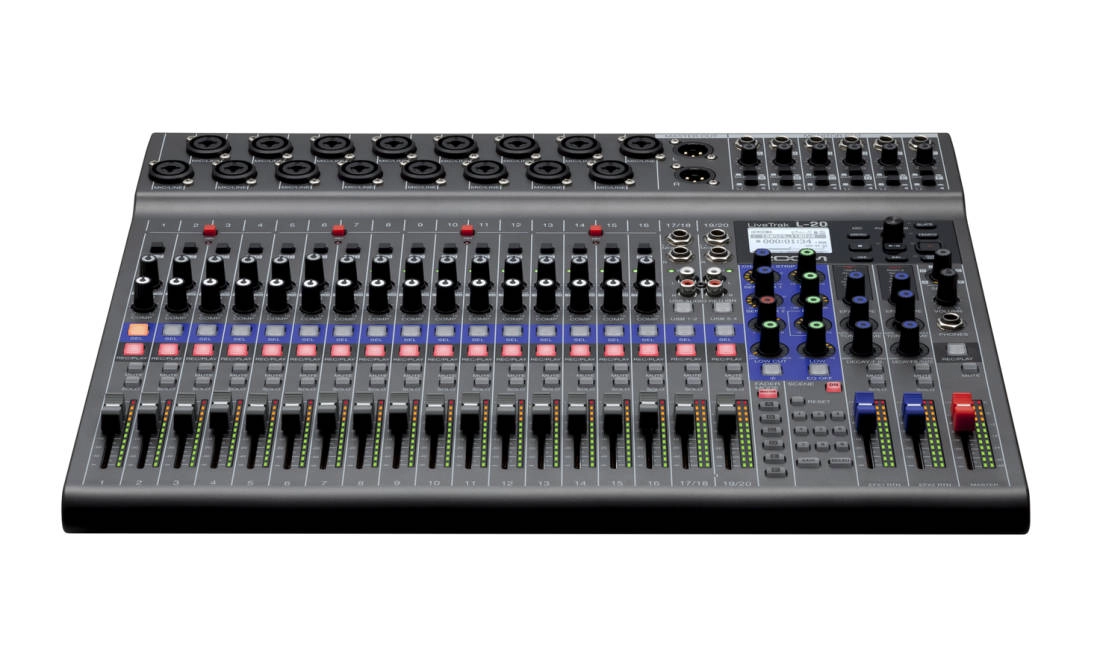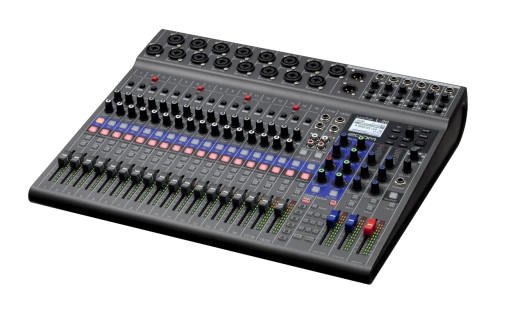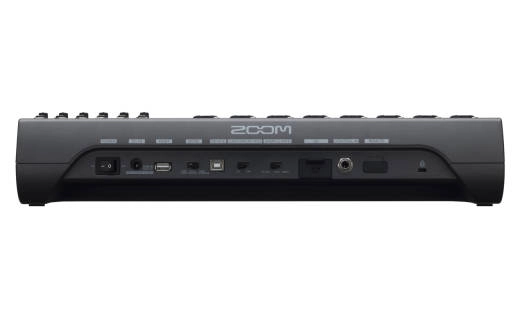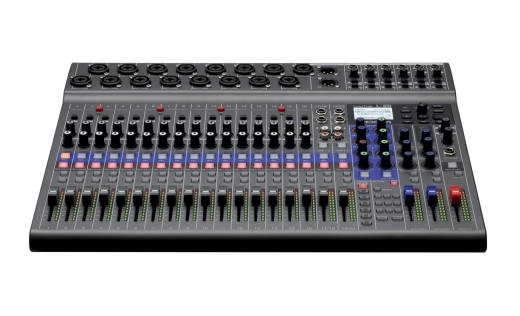Opens in a new window
Zoom LiveTrak L-20 Digital Recording/Mixing Console

Additional Photos:


MORE BOARD. MORE MUSIC.
The LiveTrak L-20 is the new digital console offering everything creators need to mix, monitor, and record complex productions. With 20 discrete audio channels and six individual custom monitor mixes, it's built for bigger, bolder arrangements.
The LiveTrak L-20 is designed to mix bigger. It features 20 inputs (16 mono mic/line inputs and two stereo inputs), all with independent 3-band mid-parametric EQ. The 16 mono inputs offer stand-alone compressor control. Record 20 discrete channels plus a stereo mix directly to an SD card. The LiveTrak L-20 captures pristine audio in resolutions up to 24-bit/96 kHz. At -128 dBu EIN with +60 dB maximum input gain, the L-20 is equipped with our quietest and most advanced preamps ever. Mix down finished songs on the L-20 or transfer your discrete tracks to a DAW to perfect later.
With six independent monitor outputs for musicians, each output can have its own custom mix, complete with effects, that can easily be switched from a powerful headphone output, to a balanced line output for stage monitors. The LiveTrak L-20 features a dedicated 7th output for the FOH engineer. The sound engineer can monitor the main mix and any of the sub mixes, thus adjusting them to the musicians' satisfaction.
Although the LiveTrak L-20 is designed to work as a stand-alone recording and mixing console, it can also be used as a 22-in/4-out USB audio interface. Audio Interface mode lets you route inputs to any DAW or streaming software, even while recording to an SD card. Additionally, audio can be routed from your computer into the L-20 to be mixed with your live performance. Class compliant mode, which enables connection with iOS devices, is supported as well.
The LiveTrak L-20 also offers wireless control via a free iOS mobile app featuring most onboard functions, including Fader Levels and Modes, Scenes, EQ, EFX sends, returns, parameters, and more. You can even manage your Effects Library and Scene Library right from your device. Control it all on either large Monitor Out view with a mini transport, or a mini Monitor Out view with expanded Transport controls.
FEATURES:
• 20 discrete channels (16 mono plus 2 stereo) with XLR or -inch connectivity
• 22-track simultaneous recording, 20-track playback
• 22-in/4-out USB audio interface connectivity
• Records up to 24bit/96kHz audio to SD card
• 48V phantom power
• Hi-Z connectivity (channels 1-2)
• 26dB pad (channels 3-16)
• Built-in compression control (Channels 1-16)
• Solo buttons for individual channels
• Variable frequency low-cut control
• Main outputs plus 6 customizable monitor outputs
• Dedicated headphone output for sound engineer
• Scene saving function, up to 9 scenes saved at a time
• 20 built-in chorus, delay and reverb effects with adjustable parameters
• Two effect busses
• Built-in slate mic
• Class-compliant mode (for iOS compatibility)
• Compatible with Remote Mixer app for iPad
• Automatic recording starting/stopping capability
• Pre-record function
• Import/export projects with USB 2.0 host port
• Compatible functions for ZOOM FS01 footswitch
• Automatic power-save function
IN THE BOX:
• LiveTrak L-20
• AD-19 AC Adapter
• USB 2.0 Cable
• Quick Guide
SPECS:
• Inputs: Mono (MIC/LINE): 16, Stereo (LINE): 2
• Output: MASTER OUT: 1, MONITOR OUT: 6, PHONES: 1
INPUTS 1-8:
• Mono (MIC/LINE): Type: XLR/TRS combo jacks (XLR: 2 HOT, TRS: TIP HOT)
• Input gain: PAD OFF: +16 - +60dB, PAD ON: - 10 - +34 dB, Hi-Z ON: +6 -+50 dB
• Input impedance: XLR: 3 kOhm
• TRS: 10 kOhm /1 M ohm (when Hi-Z ON)
• Maximum input level: PAD OFF: 0 dBu (at 0 dBFS), PAD ON: +26 dBu (at 0 dBFS)
• Phantom power: +48 V
STEREO (LINE):
• Type: TS phone/RCA pin (unbalanced) jacks, Maximum input level : +10 dBu
MASTER OUT:
• Type: XLR jacks (balanced)
• Maximum output level : +/- 14.5 dBu
• Output impedance: 100 ohms
MONITOR OUT A-F (with balanced output) connected to monitor speakers:
• Type: TRS phone jacks (balanced)
• Maximum output level: +/- 14.5 dBu
*Output impedance: 100 ohms
MONITOR OUT A-F (with unbalanced output) connected to headphones:
• Type: Standard stereo phone jacks
• Maximum output level: 42 mW + 42 mW at 60 ohms
• Output impedance: 100 ohms
PHONES:
• Type: Standard stereo phone jacks
• Maximum output level: 42 mW + 42 mW at 60 ohms
• Output impedance: 100 ohms
BUSES
• Master: 1
• Monitor: 6
• Send EFX: 2
CHANNEL STRIP
• Low Cut: 40-600 Hz, 12dB/OCT
• EQ: HIGH: 10 kHz, +/- 15 dB, shelving
• MID: 100 Hz - 8 kHz, +/- 15 dB, peaking
• LOW: 100 Hz, +/- 15 dB, shelving
LEVEL METERS
• Level segments: 12
SEND EFFECTS
• Effects: 20 types - EFX : Hall 1, (Reverb) Hall 2, (Reverb) Room 1, (Reverb) Plate, (Reverb) Church, (Reverb) DrumAmb, (Reverb) GateRev, (Reverb) Vocal 1, (Delay + Hall Reverb) Vocal 2, (Delay + Mono Reverb) Vocal 3, (Delay + Plate Reverb)
EFX 2: Hall 3, (Reverb) Room 2, (Reverb) Spring, (Reverb) Delay, (Delay) Analog, (Delay) P-P Dly, (Delay) Vocal 4, (Delay + Room Reverb) Chorus 1, (Stereo Chorus) Chorus 2, (Mono Chorus) Cho+Dly, (Chorus + Delay)
RECORDER
• Maximum simultaneous recording tracks: 22 at 44.1/48/96 kHz
• Maximum simultaneous playback tracks: 20
• Recording format: WAV 44.1/48/96 kHz, 16/24-bit, mono/stereo
• Recording media: 4 GB 32 GB SDHC cards (Class 10 or higher)
64 GB - 512 GB SDXC cards (Class 10 or higher)
AUDIO INTERFACE
• 44.1/48 kHz: Recording: 22 channels Playback: 4 channels
• Bit depth: 24-bit
• Interface: USB 2.0
SYSTEM REQUIREMENTS FOR AUDIO INTERFACE MODE
Windows:
• OS: Windows 7 SP1 or later / 8.1 / 10 (32bit/64bit)
• CPU: Intel Core i3 or faster
• USB: USB 3.0/USB 2.0
Mac:
• OS: Mac OS X 10.11 / 10.12 / 10.13
• CPU: Intel Core i3 or faster
• USB: USB 3.0/USB 2.0
iPhone/iPad:
• OS: iOS 9 / 10 / 11
USB HOST
• Class: USB 2.0 High Speed
OTHER
• Sampling frequency: 44.1/48/96 kHz
• Frequency characteristics: 44.1 kHz: -1.0 dB, 20 Hz - 20 kHz / 96 kHz: -3.0 dB, 20 Hz - 40 kHz
• Equivalent input noise: Actual measurements: -128dB EIN (IHF-A) at +60dB/150ohm input
• Display: LCD with backlight (12864 resolution)
• Power: AD-19 AC adapter (DC12V 2A)
• Power consumption: 24 W maximum
• External dimensions: 445 mm (W) 388.4 mm (D) 82.6 mm (H)
• Weight (main unit only): 3.71 kg
The LiveTrak L-20 is the new digital console offering everything creators need to mix, monitor, and record complex productions. With 20 discrete audio channels and six individual custom monitor mixes, it's built for bigger, bolder arrangements.
The LiveTrak L-20 is designed to mix bigger. It features 20 inputs (16 mono mic/line inputs and two stereo inputs), all with independent 3-band mid-parametric EQ. The 16 mono inputs offer stand-alone compressor control. Record 20 discrete channels plus a stereo mix directly to an SD card. The LiveTrak L-20 captures pristine audio in resolutions up to 24-bit/96 kHz. At -128 dBu EIN with +60 dB maximum input gain, the L-20 is equipped with our quietest and most advanced preamps ever. Mix down finished songs on the L-20 or transfer your discrete tracks to a DAW to perfect later.
With six independent monitor outputs for musicians, each output can have its own custom mix, complete with effects, that can easily be switched from a powerful headphone output, to a balanced line output for stage monitors. The LiveTrak L-20 features a dedicated 7th output for the FOH engineer. The sound engineer can monitor the main mix and any of the sub mixes, thus adjusting them to the musicians' satisfaction.
Although the LiveTrak L-20 is designed to work as a stand-alone recording and mixing console, it can also be used as a 22-in/4-out USB audio interface. Audio Interface mode lets you route inputs to any DAW or streaming software, even while recording to an SD card. Additionally, audio can be routed from your computer into the L-20 to be mixed with your live performance. Class compliant mode, which enables connection with iOS devices, is supported as well.
The LiveTrak L-20 also offers wireless control via a free iOS mobile app featuring most onboard functions, including Fader Levels and Modes, Scenes, EQ, EFX sends, returns, parameters, and more. You can even manage your Effects Library and Scene Library right from your device. Control it all on either large Monitor Out view with a mini transport, or a mini Monitor Out view with expanded Transport controls.
FEATURES:
• 20 discrete channels (16 mono plus 2 stereo) with XLR or -inch connectivity
• 22-track simultaneous recording, 20-track playback
• 22-in/4-out USB audio interface connectivity
• Records up to 24bit/96kHz audio to SD card
• 48V phantom power
• Hi-Z connectivity (channels 1-2)
• 26dB pad (channels 3-16)
• Built-in compression control (Channels 1-16)
• Solo buttons for individual channels
• Variable frequency low-cut control
• Main outputs plus 6 customizable monitor outputs
• Dedicated headphone output for sound engineer
• Scene saving function, up to 9 scenes saved at a time
• 20 built-in chorus, delay and reverb effects with adjustable parameters
• Two effect busses
• Built-in slate mic
• Class-compliant mode (for iOS compatibility)
• Compatible with Remote Mixer app for iPad
• Automatic recording starting/stopping capability
• Pre-record function
• Import/export projects with USB 2.0 host port
• Compatible functions for ZOOM FS01 footswitch
• Automatic power-save function
IN THE BOX:
• LiveTrak L-20
• AD-19 AC Adapter
• USB 2.0 Cable
• Quick Guide
SPECS:
• Inputs: Mono (MIC/LINE): 16, Stereo (LINE): 2
• Output: MASTER OUT: 1, MONITOR OUT: 6, PHONES: 1
INPUTS 1-8:
• Mono (MIC/LINE): Type: XLR/TRS combo jacks (XLR: 2 HOT, TRS: TIP HOT)
• Input gain: PAD OFF: +16 - +60dB, PAD ON: - 10 - +34 dB, Hi-Z ON: +6 -+50 dB
• Input impedance: XLR: 3 kOhm
• TRS: 10 kOhm /1 M ohm (when Hi-Z ON)
• Maximum input level: PAD OFF: 0 dBu (at 0 dBFS), PAD ON: +26 dBu (at 0 dBFS)
• Phantom power: +48 V
STEREO (LINE):
• Type: TS phone/RCA pin (unbalanced) jacks, Maximum input level : +10 dBu
MASTER OUT:
• Type: XLR jacks (balanced)
• Maximum output level : +/- 14.5 dBu
• Output impedance: 100 ohms
MONITOR OUT A-F (with balanced output) connected to monitor speakers:
• Type: TRS phone jacks (balanced)
• Maximum output level: +/- 14.5 dBu
*Output impedance: 100 ohms
MONITOR OUT A-F (with unbalanced output) connected to headphones:
• Type: Standard stereo phone jacks
• Maximum output level: 42 mW + 42 mW at 60 ohms
• Output impedance: 100 ohms
PHONES:
• Type: Standard stereo phone jacks
• Maximum output level: 42 mW + 42 mW at 60 ohms
• Output impedance: 100 ohms
BUSES
• Master: 1
• Monitor: 6
• Send EFX: 2
CHANNEL STRIP
• Low Cut: 40-600 Hz, 12dB/OCT
• EQ: HIGH: 10 kHz, +/- 15 dB, shelving
• MID: 100 Hz - 8 kHz, +/- 15 dB, peaking
• LOW: 100 Hz, +/- 15 dB, shelving
LEVEL METERS
• Level segments: 12
SEND EFFECTS
• Effects: 20 types - EFX : Hall 1, (Reverb) Hall 2, (Reverb) Room 1, (Reverb) Plate, (Reverb) Church, (Reverb) DrumAmb, (Reverb) GateRev, (Reverb) Vocal 1, (Delay + Hall Reverb) Vocal 2, (Delay + Mono Reverb) Vocal 3, (Delay + Plate Reverb)
EFX 2: Hall 3, (Reverb) Room 2, (Reverb) Spring, (Reverb) Delay, (Delay) Analog, (Delay) P-P Dly, (Delay) Vocal 4, (Delay + Room Reverb) Chorus 1, (Stereo Chorus) Chorus 2, (Mono Chorus) Cho+Dly, (Chorus + Delay)
RECORDER
• Maximum simultaneous recording tracks: 22 at 44.1/48/96 kHz
• Maximum simultaneous playback tracks: 20
• Recording format: WAV 44.1/48/96 kHz, 16/24-bit, mono/stereo
• Recording media: 4 GB 32 GB SDHC cards (Class 10 or higher)
64 GB - 512 GB SDXC cards (Class 10 or higher)
AUDIO INTERFACE
• 44.1/48 kHz: Recording: 22 channels Playback: 4 channels
• Bit depth: 24-bit
• Interface: USB 2.0
SYSTEM REQUIREMENTS FOR AUDIO INTERFACE MODE
Windows:
• OS: Windows 7 SP1 or later / 8.1 / 10 (32bit/64bit)
• CPU: Intel Core i3 or faster
• USB: USB 3.0/USB 2.0
Mac:
• OS: Mac OS X 10.11 / 10.12 / 10.13
• CPU: Intel Core i3 or faster
• USB: USB 3.0/USB 2.0
iPhone/iPad:
• OS: iOS 9 / 10 / 11
USB HOST
• Class: USB 2.0 High Speed
OTHER
• Sampling frequency: 44.1/48/96 kHz
• Frequency characteristics: 44.1 kHz: -1.0 dB, 20 Hz - 20 kHz / 96 kHz: -3.0 dB, 20 Hz - 40 kHz
• Equivalent input noise: Actual measurements: -128dB EIN (IHF-A) at +60dB/150ohm input
• Display: LCD with backlight (12864 resolution)
• Power: AD-19 AC adapter (DC12V 2A)
• Power consumption: 24 W maximum
• External dimensions: 445 mm (W) 388.4 mm (D) 82.6 mm (H)
• Weight (main unit only): 3.71 kg
Q & A
There are currently no questions for this product.
Reviews
18.222.147.70
Mozilla/5.0 AppleWebKit/537.36 (KHTML, like Gecko; compatible; ClaudeBot/1.0; [email protected])
Well conceived mixer. 1 of 1 customers found this review helpful
Features
Quality
Value
Overall
Product Experience I own it
Closest Store Kingston, Ontario
With any piece of gear the designers have to make a lot of decisions as to what to include and what to leave out. They did very well when making decisions on this mixer. It doesn't do everything but it does most things and what it does it does well. The pre-amps are nice, the one knob compressors work well when used like a mixer compressor should be used (for subtle compression for the mix not as an effect). The eq section is simple and the high pass filters are just what is needed and nothing more. There isn't a lot of numerical interface so you are forced to use your ears which is what people should be doing anyway. Things that it doesn't do can be worked around by adding outboard gear. For the price this is an excellent tool.
Posted by Dave Webb on Jan 20, 2025
Delighted so far 8 of 8 customers found this review helpful
Features
Quality
Value
Overall
Product Experience I own it
Closest Store Saskatoon, Saskatchewan
I have enjoyed using this mixer so far. I haven't explored all the features, but am very pleased with the Bluetooth remote capability. Aside from having to order the BT plug which was about $30, it works well. It only runs off an iPad. I noticed a definite improvement in sound quality over the Behringer mixer I was using previously, which attests to the quality of the preamps and circuitry. The effects sound great, with lush reverbs. On my wish list: another set of RCA ins, balanced lines out for mains in addition to the xlr's, and a heavier-duty cord for the power adapter. The thin cable obviously isn't intended for the road, and I could see that this could break if not looked after carefully. Aside from that, I am very pleased with this mixer and will be using it for both live gigs, rehearsals, student recitals, and so on, and recording some demos.
Posted by Ben on May 8, 2019
Zoom LiveTrak L-20 Usage Experience 52 of 56 customers found this review helpful
Features
Quality
Value
Overall
Product Experience I own it
Closest Store Nanaimo, British Columbia
As likely one of the first customers to purchase an L-20 in Western Canada, I decided to post a review. Some customer reviews are long. This one is really long. Intended use is an important context when reviewing a piece of audio equipment as complex as a multi-track recorder with 20 inputs and 458 discrete controls not including menu items. Part of that context is that I prefer a physical recorder rather than a digital audio workstation because it is inconvenient/distracting to use a mouse when holding a guitar. I often perform and record at the same time.
I have reviewed separately each of the different types of recording projects that I have used the L-20 for:
Personal Recording
I often practice new songs by performing each of the musical parts (guitars, bass guitar, drums, vocals) myself. This type of recording is usually done with a Zoom R24 or a Zoom R8. The L-20 is a ?big hammer for that size of nail?. The R24 and R8 have some features for this task that the L-20 doesn't have, like separate Mark Forward/Mark Reverse buttons, A/B Repeat, Auto Punch I/O, more elaborate effects grouped by instrument type, more project and file manipulation commands, rhythm functions and mastering algorithms built-in. The foot switch on the L-20 is a nice addition that I enjoyed on some my previous Tascam recorders (Portastudio and BR600). The sound quality on the L-20 seems better than the smaller Zoom products I use. This may be due to age and over-use of the controls on the R24. If I need a practice recorder when travelling I will still take the portability of the R8. If I just need 8 tracks at home I might still use the R24. This type of project is not the purpose that the L-20 was designed for. Over time I may change my mind about this as I more familiar with the L-20.
Group Recording at Home
Most Sunday evenings 8 to 10 like minded musicians meet at my house to play music together. Hosting 6 singing guitar players (electric and acoustic) along with drums and bass is not practical without the use of headphones and direct injection of instruments for all performers. Up to now, this has been accomplished with two R24's ganged together coordinating using the USB connection and nine individual satellite mixers, one for each performer. Each performer gets to control the volume of their instrument and vocals overlaid on the master mix. The 16 channels of recording provides ready feedback on our musical progress. This setup works well, but it is a real pain to set up and tear down each week. I admired the L-12 over the past year, but the simple math of available inputs versus those required didn't add up.
This week we debuted the LiveTrak L-20. Everyone agreed that it was a far superior setup. The sound quality was better. The six separate monitoring buses were put to good use (with an additional 4 channel headphone amplifier distributing the master mix to some of the performers) replacing most of the mixers. The compression, panning, EQ and effect sends are effective and pleasant to use.
Group Recording a Public Performance
Shortly after purchasing the L-20 I had the opportunity to record a 6 person rock group who were playing in a modest sized community hall. This is situation that the L-20 was ?born for?. It is obvious that the design engineers wanted to build a portable recording solution for real-world live situations. With very little experience or practice with the L-20, I produced two hours of very agreeable recordings. The recorder doesn't solve the problems of microphone placement and spaghetti cabling for this purpose, but the L-20 performed its function flawlessly.
I am looking forward to the padded carrying bag for the L-20. This will enhance its purpose as a ?portable? many-channel recorder.
I can comment further on some specific features that I have enjoyed while using the L-20 over the past week ...
LED Level Meters
The easily visible LED level indicators on each channel alongside the faders was a deciding factor in my purchase of the L-20 compared to the new Tascam product that was recently announced. The metering allows me at a glance to ensure that all of the levels are OK even while I am distracted playing guitar with the band. A caution regarding the LED level meters is that they are used for multiple purposes including the recording level, the playback level and the previous fader position. This is a good feature, but you need to get familiar with it or it will trip you up.
?Scenes? Management
The ability to save all of the recorder settings is an important tool to manage the complexity of the many available settings. Once all of the settings (levels, EQ, effects, panning) have been optimized and saved then the next time the recorder is used for the same purpose (with the same input sequence by instrument) then all the settings can be recalled with a three button sequence. Very useful.
Preamp and Sound Quality
As mentioned the recorder sounds ?clean? in use. The preamps are more sensitive than the Zoom R24 so if you turn up the gain all of the way you can hear some noise, but for a typical vocal microphone the gain control is set to 50% where it is ?dead? quiet. The Zoom 24 gain would be set to about 90% for the same conditions.
Monitoring Outputs
The 6 monitoring outputs plus the phones output is a generous arrangement. Setting up each monitoring output with a customized mix of the 20 inputs takes a bit of setup, but once you are done, that is what the Scenes feature is for. It all gets remembered.
Two Effects Buses
The effects were easily used, particularly for vocals. Everyone appreciated the improvement in their vocal sound.
Mute and Solo Buttons
The smaller Zoom recorders don't have these features. After a few days I can't record happily without them, particularly Solo, which isn't available on the L-12. More inputs need better management and these features help.
Slate Input Microphone
Previously as the recording engineer, I just yelled loud enough that the other performers could hear me while they had their headphones on. The slate button and microphone work much better for this purpose.
Remote Foot Switch
Not a new invention, my Tascam Portastudio had one in the early 1980's, but nice to have back again. I can cue the recorder, move over to the drum throne and then activate the recording function from there with a suitably long cable on the foot switch.
iPad Remote App
I bought the Bluetooth adapter and downloaded the Zoom L-20 Control app onto an iPad. I haven't tried it in a live performance situation yet, but it seemed very intuitive and provided good range (even around corners) in my house. I am looking forward to trying it in a public performance situation. I was never comfortable with the iPad control only recording technology so having the full control panel available as the main interface is a comfort and convenience.
Customer Support
Shortly after purchase, I misinterpreted an ?operator error? on my part as a product defect. I emailed Zoom with my concern and they (Zoom North America) responded the next business day with some further questions and an obvious enthusiasm for helping to determine the problem. I was able to solve the problem myself the next day so I can't report on how they would have handled a product return situation. They did however continue to correspond regarding some feature suggestions I offered for a future firmware upgrade. Good customer support.
Opportunities for Improvement
Some of the design choice compromises for the L20 are understandable. It is clear that they wanted to maintain the same width as the L12, so the shuttle controls had to move towards the top of the panel which makes them a bit less convenient. The designers probably wanted to keep the L20 relatively portable, so the pan/tone/effect send controls are shared across all channels. This also makes it more practical to capture these encoder based functions with the Scene feature. Zoom may also have decided that some of the post-recording functions that I enjoy on the R24 are best served on the L20 by a connected computer with digital audio software.
There are a number of features that I would enjoy if they could be made available as upgrades in a future firmware release:
A/B looping as a menu setting to loop between previously set track marks.
Pressing Stop + Reverse together should take you to the beginning of the present project (like on the R24), then to the beginning of the previous project with the next press. Pressing Stop + Forward together should take you to the end of the present project and then to the next project with the next press.
When the Stop button is not pressed with the Mark Rewind button it should not take you to the beginning of the previous project when you go past the start of the project you are working on.
Ability to set automatic punch-in and punch-out positions. This could rely on the Track Mark feature already available and be implemented as a menu item (record at next mark, stop recording at the following mark)
Tenths of a second option on the time display. (without this you have to wait one second to confirm that the unit is actually recording and the extra resolution would be helpful if an automatic punch in/out was implemented)
Folder renaming.
Adding some simple mastering algorithms like the R24 has is probably a reach too far if the processor is busy dealing with 20 channels while recording.
The addition of my suggested upgrades to firmware would probably eliminate my use of the R24 for practice and learning projects. For tonal mastering of the mixed track from the L-20, I can just dub from the L-20 outputs to to a stereo track on the R24 or R8 with their mastering effects enabled. I haven't tried this yet as I have been satisfied with the tone and volume balance of each of the songs mixed.
Some suggested improvements (a very short list) that would not be trivial as they involve the control surface:
Dedicated flat surfaces for applying track labels. 3/4? masking tape can be applied below the input jacks and below the faders, but these surfaces aren't designed for the task. 20 recording inputs needs good labelling.
Larger shuttle buttons. (not practical without making the unit larger, which is not desirable)
In my opinion, the Zoom L-20 is the best multi-track recorder available for recording live performances with larger groups, while providing tactile controls, good monitoring flexibility, the most commonly used sound shaping features for each channel and a conveniently portable size/weight relative to the purpose. (especially when the padded carry bag becomes available) I can recommend the L-20 for musicians who have needs similar to mine.
I don't normally write reviews, but I read a lot them when making a significant purchase. Hopefully this review will be helpful for other people with similar interests who are considering a similar purchase. This review is just one person's opinion and I am not a professional musician or studio engineer. I didn't give the L-20 5 stars everywhere because someone else is going to compare it to some professional studio gear and want to start an argument. That is probably OK as the L-20 is targeted at home musicians and the budgets they work with. If Zoom do manage to add in the extra features I suggested, then it would be 5 stars everywhere for me. The Zoom LiveTrak L-20 is well meeting my needs and expectations.
Posted by Bart on Oct 30, 2018





